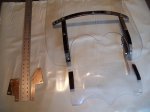xguidojr
.020 Over
After putting up with buffeting for the last two years, I finally came up with a solution.
First, went from the stock 21” windscreen to a Clearview 25” with recurve top edge. This helped some, but there was still some turbulence around my head. Even after extending the windscreen to its maximum height, the problem persisted. The problem intensified when I bought a 1 ½” pad for the saddle.
Looking at the stock mounting hardware, I could see that if the “leg” on mounting plate was longer, the windscreen could be raised. A $5 piece of 1/8” aluminum did the trick. Using the stock plate as a template (see pictures) I fabed a replacement plate with a 2 ½” longer leg. This got rid of the turbulence at head level, but opened up a huge gap between the windscreen and headlights, which, in Northern Michigan, can cause a pretty uncomfortable blast of cold air in the mornings and evenings. The solution was to cut out the headlight surround from the old windscreen and attach it to the windshield brace with Velcro strips. (See picture). This is easily removed for warmer days. It was necessary to “reform” the cutout so that it conformed to the contour of the windscreen. This is easily done by heating the piece to about 350*F in your oven and quickly forming it using the windscreen as a mold (don’t forget to have gloves or oven mitts handy). If you don’t happen to have a “donor” windscreen, this part can be made from a piece of heavy polycarbonate (Plexiglas) available at your local hardware store using the windscreen as a template.
Not only did this eliminate the buffeting, it made a significant reduction in wind noise – so much so that for shorter rides, I no longer have to wear earplugs.
First, went from the stock 21” windscreen to a Clearview 25” with recurve top edge. This helped some, but there was still some turbulence around my head. Even after extending the windscreen to its maximum height, the problem persisted. The problem intensified when I bought a 1 ½” pad for the saddle.
Looking at the stock mounting hardware, I could see that if the “leg” on mounting plate was longer, the windscreen could be raised. A $5 piece of 1/8” aluminum did the trick. Using the stock plate as a template (see pictures) I fabed a replacement plate with a 2 ½” longer leg. This got rid of the turbulence at head level, but opened up a huge gap between the windscreen and headlights, which, in Northern Michigan, can cause a pretty uncomfortable blast of cold air in the mornings and evenings. The solution was to cut out the headlight surround from the old windscreen and attach it to the windshield brace with Velcro strips. (See picture). This is easily removed for warmer days. It was necessary to “reform” the cutout so that it conformed to the contour of the windscreen. This is easily done by heating the piece to about 350*F in your oven and quickly forming it using the windscreen as a mold (don’t forget to have gloves or oven mitts handy). If you don’t happen to have a “donor” windscreen, this part can be made from a piece of heavy polycarbonate (Plexiglas) available at your local hardware store using the windscreen as a template.
Not only did this eliminate the buffeting, it made a significant reduction in wind noise – so much so that for shorter rides, I no longer have to wear earplugs.

